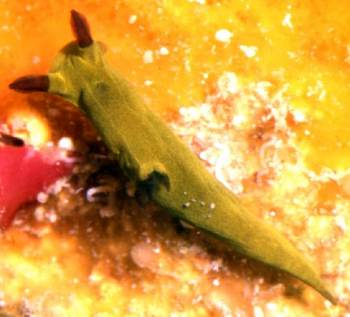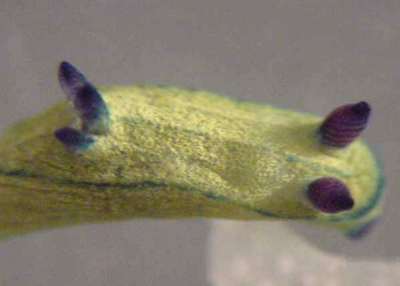
Tambja oliva
Meyer, 1977
Order: NUDIBRANCHIA
Suborder: DORIDINA
Superfamily: ANADORIDOIDEA
Family: Polyceridae
Subfamily: Nembrothinae
DISTRIBUTION
Known from a few records from the Caribbean region.
PHOTO
Photo from J.L.Cervera of specimen from the Bahamas. Photographer: Jack Worsfold.
The shape of this species is typical for the genus. The body is a deep olive green to light green or olive yellow, often with microscopic flecks of yellow, blue or turquoise. The tips of the gills, posterior foot, and oral tentacles are light to dark purple or a dark blue-green. The rhinophores are very dark, often purple or translucent white with opaque cream spots. Grows to at least 20 mm in length. Radular typical of the genus Tambja.
This species is known from a few records from the Caribbean region.
-
Meyer, K. B. (1977) Dorid nudibranchs of the Caribbean coast of
the Panama Canal Zone. Bulletin of Marine Science, 27(2): 299-307.
Rudman, W.B., 2005 (August 23) Tambja oliva Meyer, 1977. [In] Sea Slug Forum. Australian Museum, Sydney. Available from http://www.seaslugforum.net/find/tamboliva
Related messages
Re Tambja oliva from South Carolina, USA
September 5, 2005
From: Rachael King
Dr. Rudman,
Ray Simpson contacted us recently about an image of Tambja oliva that we have in the photo gallery on our website [message #14592 ]. The specimen was taken at 170 ft depth off South Carolina on a submersible dive (Johnson Sea Link) as part of a NOAA expedition we were involved in in 2003.
I'm a crustacean taxonomist and have very limited abilities with molluscs thus we have not moved very far ahead with our molluscan identification work. We have only one specimen of that species so far, but we are still processing material from our 03/04 sampling seasons.
All the best,
Rachael
Dr. Rachael King
Southeastern Regional Taxonomic Center
Marine Resources Research Institute
http://www.dnr.state.sc.us/marine/sertc/
sertc@mrd.dnr.state.sc.us
King, R., 2005 (Sep 5) Re Tambja oliva from South Carolina, USA. [Message in] Sea Slug Forum. Australian Museum, Sydney. Available from http://www.seaslugforum.net/find/14702Thanks Rachael,
Bill Rudman
Tambja oliva? from North Carolina, USA
August 24, 2005
From: Ray Simpson

Here's a picture (it is not mine but it's remained unidentified for some time on the Southeastern Regional Taxonomic Center (SERTC) website. The photo was taken by Jerry McLelland during the 2003 Explorer cruise to offshore hard bottoms off the South Carolina coast.
Locality: Carolina shelf edge, South Carolina. USA West Atlantic. Photographer: Jerry McLelland
The species resembles Tambja oliva, previously known only from Central America. The olive-yellow base color with blue rhinophores and gills seems to fit the description of T. oliva. As you discuss [message #14292] I wouldn't be surprised if T.? gratiosa was indeed a Roboastra and T. oliva was its food. It seems that there are Roboastra/Tambja predator/prey pairings... i.e. ?gratiosa / oliva in the NW Atl. and the undescribed sp./ stegasauriformis or divae in the SW Atl. I'd love to see a picture of T. divae, it seems like a stunning animal! The SERTC website is at http://www.dnr.state.sc.us/marine/sertc/)
Thanks for reading my babbling :)
Ray Simpson
P51MustNB@aol.com
Simpson, R., 2005 (Aug 24) Tambja oliva? from North Carolina, USA. [Message in] Sea Slug Forum. Australian Museum, Sydney. Available from http://www.seaslugforum.net/find/14592Dear Ray,
I suspect this animal is Tambja oliva but we have so little information on it that it is hard to be sure of the variability to be expected in the species. I have posted a photo, kindly provided by Lucas Cervera, of a specimen from the Bahamas on the new Fact Sheet. The only other photo I know of are the quite yellow specimens on the Slug Site at http://slugsite.us/bow/nudwk409.htm.
Since discussing the generic position of Tambja? gratiosa I have seen the recent description of Tambja tentaculata which has Roboastra-like oral tentacles so we will really need to look at the anatomy of T. gratiosa before we can be sure. I have alerted Lucas Cervera and Marta Pola to a possible source of specimens so hopefully we won't have to wait too long for the mystery to be solved.
Best wishes,
Bill Rudman
